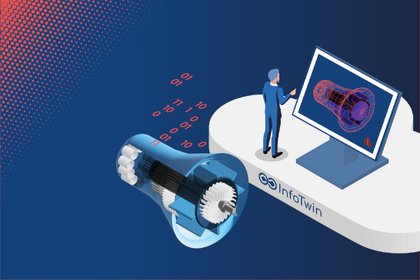Why your competitors are not yet using Big Data
Big Data in industry describes the flood of data created by digitization in machines and plants. Manufacturers should not approach the abundance of data with fear, but see it as an opportunity. It provides valuable information that can be used to save a lot of money.
Nevertheless, the "data gold" is still lying around unused at many machine and plant manufacturers. We show you which hurdles you should overcome to leave the competition behind and successfully monetize your data.
A recent study shows that service is already an important economic stabilizer for many machine builders. According to the study, companies that expand their service regularly generate more than 50% of their profits with it. However, according to another survey of industrial companies, less than 5% are using applications like predictive maintenance to achieve this dream rate.
5 reasons why Big Data is a challenge in machine building
There are several factors that still prevent many manufacturers from fully exploiting the crisis-proof revenue potential in after-sales service. These are the top 5 reasons why Big Data is still too rarely monetized:
1. LACK OF KNOW-HOW
Using and monetizing data in service - that doesn't sound difficult in principle. In practice, however, there is often a lack of the necessary expertise and, above all, the specialists who can analyze data and derive meaningful strategies from it.
2. RIGID SILO THINKING
Silo thinking still prevails in many companies. Departments work at cross purposes instead of with each other. Silos are not only evident in collaboration, but are also noticeable when looking at data structures: Today, information that is supposed to make the service business future-proof is often scattered across several departments and employees.
Different formats, local storage locations, redundancies - all this means that data must first be extracted from different systems and unified before outdated data silos can be turned into productive data gold mines.
3. DATA BLINDNESS
The fact that data is distributed decentrally throughout the company is not only due to silos. Often, there is simply no central platform where information can converge and be clearly analyzed.
If manufacturers can't even manage to bring transparency to their flood of big data internally, how are they supposed to use the information efficiently and build data-based business models for plant operators on it?
4. LACK OF RESOURCES
Implementing a system that provides the visibility needed for efficient data management often fails in practice due to resources. Companies either balk at the cost of implementing software or don't have the time or manpower to implement a system to monetize data.
5. INEFFICIENT TOOLS
Even when vendors manage to implement a tool that aggregates and prepares data, many of them do not use the tool efficiently. Too many features, too little flexibility, and overly complex processes are not what after-sales service needs for a revenue push.
No Big Data is no solution either: why is it risky not to use data?
If you let the flood of data overwhelm you instead of leveraging it in after-sales service, lucrative new revenue streams will remain permanently closed. Companies that do not face up to the challenges of digitization are giving away growth opportunities and risking disadvantages in service:
- high effort for service employees to find information
- expensive service costs for low margins
- Stagnating spare parts sales due to outdated information or incorrect orders due to lack of data
- unnecessarily many trips by service technicians for one order - resulting in high travel costs and blocked resources
- low first time fix rate and decreasing customer satisfaction
Many companies in the engineering sector have yet to overcome the above challenges, and until they do, they will have to put up with the disadvantages in after-sales service. Be one step ahead of the competition - take advantage of data and turn Big Data into a Big Win.
You can read about the advantages this will give you and how to monetize your data step by step in the following parts of this article series.



